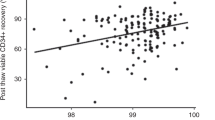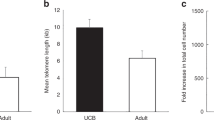Abstract
Isolation of large numbers of human peripheral blood CD34+ cells could lead to therapeutic applications, including purging of malignant cells from blood cell transplantations, purging of T cells from allogeneic bone marrow, and even blood cell transplantation. This procedure has limitations if there are not sufficient numbers of progenitor cells in the leukapheresis concentrates available for selection after detection of tumor cells in apheresis products. Use of frozen/thawed peripheral blood mononuclear cell (PBMC) samples would make feasible pooling of two or even more stem cell harvests collected at different time points and the total number of CD34+ progenitor cells available would increase. We established an efficient method for purification of CD34+ cells from cryopreserved apheresis products, using a nylon-fiber syringe system and immunomagnetic microspheres. We compared purity, recovery rate and clonogenicity of CD34+ cells purified from fresh (n = 22) and cryopreserved apheresis products (n = 14), using a nylon-fiber syringe system and immunomagnetic microspheres. The purity of CD34+ cells from cryopreserved products was less than that from fresh products (85.9 ± 14.4% vs 94.6 ± 10.0%), but the recovery rate of CD34+ cells and colony-forming cells was comparable between fresh and cryopreserved products. One patient underwent grafting with peripheral blood CD34+ cells selected after freezing, with good success. Therefore, these cells are capable of rapidly reconstituting hematopoiesis after high-dose chemotherapy. Bone Marrow Transplantation (2000) 26, 787–793.
This is a preview of subscription content, access via your institution
Access options
Subscribe to this journal
Receive 12 print issues and online access
$259.00 per year
only $21.58 per issue
Buy this article
- Purchase on Springer Link
- Instant access to full article PDF
Prices may be subject to local taxes which are calculated during checkout



Similar content being viewed by others
References
Brenner MK, Rill DR, Moen RC et al. Gene-marking to trace origin of relapse after autologous bone-marrow transplantation Lancet 1993 341: 85–86
Deisseroth AB, Zu Z, Claxton D et al. Genetic marking shows that Ph+ cells present in autologous transplants of chronic myelogeneous leukemia (CML) contribute to relapse after autologous bone marrow in CML Blood 1994 83: 3068–3076
Rill DR, Santana VM, Robert WM et al. Direct demonstration that autologous bone marrow transplantation for solid tumors can return a multiplicity of tumorigenic cells Blood 1994 84: 380–383
Moss TJ, Sanders DG, Lasky LC et al. Contamination of peripheral blood stem cell harvests by circulating neuroblastoma cells Blood 1990 76: 1879–1883
Ross AA, Cooper BW, Lazarus HM et al. Detection and viability of tumor cells in peripheral blood stem cell collections from breast cancer patients using immunocytochemical and clonogenic assay techniques Blood 1993 82: 2605–2610
Holyoake TL, Alcorn MJ, Franklin IM . The CD34 antigen: potential clinical advantages of CD34 selection Clin Oncol R Coll Radiol 1996 8: 214–221
Corringham RE, Ho AD . Rapid and sustained allogeneic transplantation using immunoselected CD34+ selected peripheral blood progenitor cells mobilized by recombinant granulocyte and granulocyte–macrophage colony-stimulating factors Blood 1995 86: 2052–2054
Link H, Arseniev L, Bahre O et al. Transplantation of allogeneic CD34+ blood cells Blood 1996 87: 4903–4909
Bohbot A, Lioure B, Faradji A et al. Positive selection of CD34+ cells from cryopreserved peripheral blood stem cells after thawing: technical aspects and clinical use Bone Marrow Transplant 1996 17: 259–264
Martinson JA, Loudovaris M, Smith SL et al. Ex vivo expansion of frozen/thawed CD34+ cells isolated from frozen human apheresis products J Hematother 1997 6: 69–75
Alcorn MJ, Holyoake TL, Richmond LJ et al. CD34+ cells can be selected efficiently from cryopreserved peripheral blood progenitor cells and can retain their proliferative potential J Hematother 1997 6: 501–510
Farley TJ, Ahmed T, Fitzgerald M et al. Optimization of CD34+ cell selection using immunomagnetic beads: implications for use in cryopreserved peripheral blood stem cell collection J Hematother 1997 6: 53–60
Koizumi K, Sawada K, Sato N et al. Large scale purification of human blood CD34+ cells using nylon-fiber syringe system and immunomagnetic microspheres Cytotherapy 1999 1: 319–327
Yamaguchi M, Sawada K, Sato N et al. A rapid nylon-fiber syringe system to deplete CD14+ cells for positive selection of human blood CD34+ cells. Use of immunomagnetic microspheres Bone Marrow Transplant 1997 19: 373–379
Sawada K, Sato N, Notoya A et al. Proliferation and differentiation of myelodysplastic CD34+ cells: phenotypic subpopulation of marrow CD34+ cells Blood 1995 85: 194–202
Clarke BJ, Housman D . Characterization of an erythroidprecursor cell of high proliferative capacity in normal human peripheral blood Proc Natl Acad Sci USA 1977 74: 1105–1109
Tarumi T, Sawada K, Koizumi K et al. A pilot study of a response oriented chemotherapeutic regimen combined with autologous peripheral blood progenitor cell transplantation in aggressive non-Hodgkin’s lymphoma Leuk Lymphoma 1999 34: 361–371
Brugger EJ, Henschler R, Heimfeld S et al. Positively selected autologous blood CD34+ cells and unseparated blood progenitor cells mediated identical hematopoietic engraftment after high-dose VP16, ifosfamide, carboplatin, and epirubicin Blood 1994 84: 1421–1426
Berenson RJ, Bensinger WI, Kalamasz D et al. Engraftment of dogs with Ia-positive marrow cells isolated by avidin-biotin immunoabsorption Blood 1987 69: 1363–1367
Winslow JM, Liesveld JL, Ryan DH et al. CD34+ progenitor cell isolation from blood and marrow: a comparison of techniques for small scale selection Bone Marrow Transplant 1994 14: 265–271
Lang P, Schumm M, Taylor G et al. Clinical scale isolation of highly purified peripheral CD34+ progenitors for autologous and allogeneic transplantation in children Bone Marrow Transplant 1999 24: 583–589
Koizumi K, Sawada K, Nishio M et al. Effective high-dose chemotherapy followed by autologous peripheral blood stem cell transplantation in a patient with the aggressive form of cytophagic histiocytic panniculitis Bone Marrow Transplant 1997 20: 171–173
Hashimoto H, Sawada K, Koizumi K et al. Effective high dose chemotherapy combined with total body irradiation (TBI) following CD34+-selected autologous peripheral blood stem cell transplantation in a patient with subcutaneous panniculitic T cell lymphoma (SPTCL) that transformed into leukemia at first relapse Bone Marrow Transplant 1999 24: 1369–1371
Nachbaur D, Fink FM, Nussbaumer W et al. CD34+-selected autologous peripheral blood stem cell transplantation (PBSCT) in patients with poor-risk hematological malignancies and solid tumors. A single-center experience Bone Marrow Transplant 1997 20: 827–834
Oda A, Sawada K, Druker BJ et al. Erythropoietin induces tyrosine phosphorylation of Jak2, STAT5A, and STAT5B in primary cultured human erythroid precursors Blood 1998 92: 443–451
Haseyama Y, Sawada K, Oda A et al. Phosphatidylinositol 3-kinase is involved in the protection of primary cultured human erythroid precursor cells from apoptosis Blood 1999 94: 1568–1577
Acknowledgements
We are grateful to Dr CI Civin for the generous gift of monoclonal antibodies, Dr SC Clark and the Genetics Institute, Chugai Pharmaceutical Co. and Kirin Brewery Co. for the generous gifts of recombinant human growth factors, to S Okazaki for manuscript preparation, to M Ohara for helpful comments, M Kitayama and I Satoh for technical assistance. This work was supported by a Grant-in-Aid from the Ministry of Education, Science, Sports and Culture of Japan (12670470), Sankyo Foundation of Life Science, and Idiopathic Disorders of Hematopoietic Organs Research Committee supported by the Ministry of Health and Welfare of Japan.
Author information
Authors and Affiliations
Rights and permissions
About this article
Cite this article
Koizumi, K., Nishio, M., Endo, T. et al. Large scale purification of human blood CD34+ cells from cryopreserved peripheral blood stem cells, using a nylon-fiber syringe system and immunomagnetic microspheres. Bone Marrow Transplant 26, 787–793 (2000). https://doi.org/10.1038/sj.bmt.1702601
Received:
Accepted:
Published:
Issue Date:
DOI: https://doi.org/10.1038/sj.bmt.1702601



